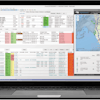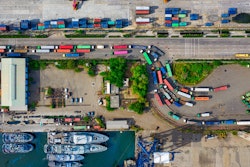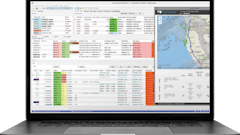
The past year in international sports has been a unique one, with the 2020 Summer Olympics and the 2022 Winter Olympics held just a few months apart. It’s no secret what caused that disruption, especially for those who work in the supply chain. Pandemic aside, the Olympics and the supply chain have more in common than you might think: the Olympic games bring together international teams for a common goal; the supply chain brings people and vital goods together no matter where they’re located.
Delays and disruptions happen–take the Summer 2020 Olympics or gridlocks at key coastal ports as an example. And naturally, there are many companies finding themselves needing to adjust to the unexpected. For a business to win that gold medal in supply chain excellence, they must have a plan that factors in visibility to drive agility, efficiency and resiliency.
While the 2022 Winter Olympics have come and gone, that doesn’t mean you can't still take home the gold. So, it’s time to build your supply chain dream team, consisting of three core elements: a warehouse management system (WMS), transportation management system (TMS), and transportation execution system (TE).
Let’s first look at all three individually.
Warehouse management systems
A core part of any supply chain team is the Warehouse Management System (WMS). WMS is a software solution that optimizes a warehouse from the floor to the loading dock of the distribution center. WMS manages both the inventory and network where the product sits and helps determine how it should be processed internally once an order is taken. WMS typically improves inventory accuracy and organization, lean workforce challenges, and overall control of the facility.
Naturally, the key to visibility is having eyes on all pieces of inventory. It’s fairly common to forget stock that has been shoved in a corner or have an abundance of SKUs that are difficult to keep track of manually. WMS manages the inventory and network of where the product sits, factors in how it will be processed, and determines the most efficient route to and from the loading dock and storage areas. WMS also cuts down on repetitive tasks for the workforce, helping lower the chance of on-the-job injury and a better quality of life–a central element in helping solve the workforce crisis.
While WMS brings speed and organization to the supply chain team, once those products are loaded into the distribution network, those orders essentially get “lost.” Unless you have a TMS, that is.
Transportation management systems
Transportation Management Systems (TMS) act as the supply chain team captain–taking control and bringing the entire supply chain together. The key difference is network optimization and planning. A TMS is ultimately powerful software that has a network designed to cross departments, locations, and find the cheapest and fastest route to the customer and execute it all in one platform.
Often, large-scale, global companies have redundancies in software and processes–one division in Norway is using one software product to identify carrier routes, while a different division in Canada is using entirely different software. These same divisions may be manually re-inputting data in a spreadsheet, taking valuable time from key employees and delaying delivery timelines. Additionally, if a company makes 5,000 shipments a day and isn’t using the lowest cost and most efficient carrier, they are creating long cycle times and inopportune delivery times–resulting in excess inventory and waste.
A TMS can help unify those areas on a global scale, automating processes and finding the best route and carrier. A proper TMS solution allows you to have visibility on the whole shipment execution process (across departments, territories and processes), giving companies ultimate control over the entire distribution process. Regardless of whether the item is being imported or exported, you maintain uniform shipping procedures for parcel, LTL (Less than Truckload), TL (Truckload), freight, or courier. As regulations, compliance and workforce shortages evolve domestically and globally, being able to see and adjust to that change in real-time leads to greater efficiency and cost savings.
With a TMS and WMS, your supply chain team will be tough to match, but there’s one more player that can bring home the gold.
Putting the “TE” in team: transportation execution solutions
Transportation Execution (TE) is sometimes mistaken for TMS, but is the member of the supply chain team that crosses the finish line. While the process to get a product from a company’s four walls to the customer can be complicated, it’s TE that simplifies the process.
TE automates and streamlines transportation practices, inducting those packages and shipments from the warehouse into a carrier network. This ultimately optimizes visibility, efficiency and flexibility of the overall supply chain. TE will automatically choose the most efficient and cost-effective carrier, route and shipment consolidation process. The software creates freight spend visibility reports to help reduce costs and automates manual workflows to reduce errors and duplicate processes across all modes of transportation.
A TE solution can be customized based on a company’s–or its country of origin’s–rules and requirements, inputting specific guidelines to be automated and put into a carrier network. With TE, supply chains have the ability to quickly assess situations and find alternatives on the fly.
Building the Dream Team
Each system is a major player to the team, but it all goes back to network design. Let’s say there is a scenario where you have three to four sites. The WMS will help you keep visibility of product, increase worker agility, and maintain control of the warehouse sites, TMS can tell you where your inventory is and how to move it in the most efficient and cost-effective way, while the TE system will make sure they are properly sent out in the most efficient manner possible.
Just as Olympic athletes train for years to get to the podium, companies in the supply chain need to be thinking years in advance to stay competitive. The next steps lie in your hands. Conduct a Time Value study to start. It is as simple as setting your smartphone timer and timing processes from storing products to labeling packages. This will identify where a WMS, TMS and TE may help, or where they’re falling short. Large corporations are already taking advantage of these processes and it’s time mid-size companies join, too.
The supply chain is constantly evolving; it’s time you had the software to support it and stay agile against the competition. Let the games begin!


![Pros To Know 2026 [color]](https://img.sdcexec.com/mindful/acbm/workspaces/default/uploads/2025/08/prostoknow-2026-color.mduFvhpgMk.png?auto=format%2Ccompress&bg=fff&fill-color=fff&fit=fill&h=100&q=70&w=100)







![Pros To Know 2026 [color]](https://img.sdcexec.com/mindful/acbm/workspaces/default/uploads/2025/08/prostoknow-2026-color.mduFvhpgMk.png?ar=16%3A9&auto=format%2Ccompress&bg=fff&fill-color=fff&fit=fill&h=135&q=70&w=240)








